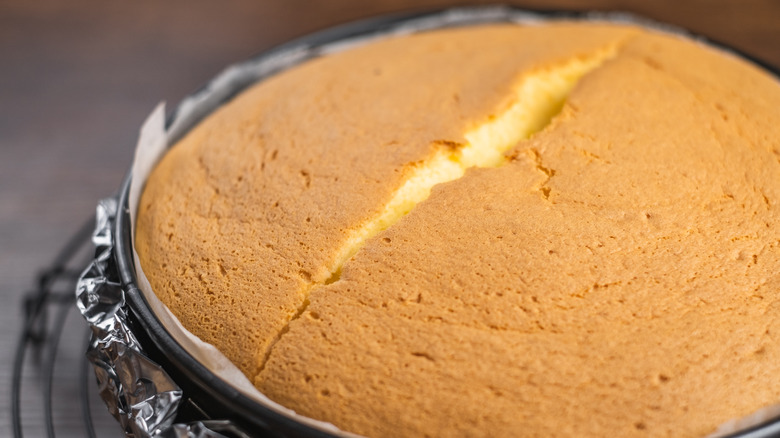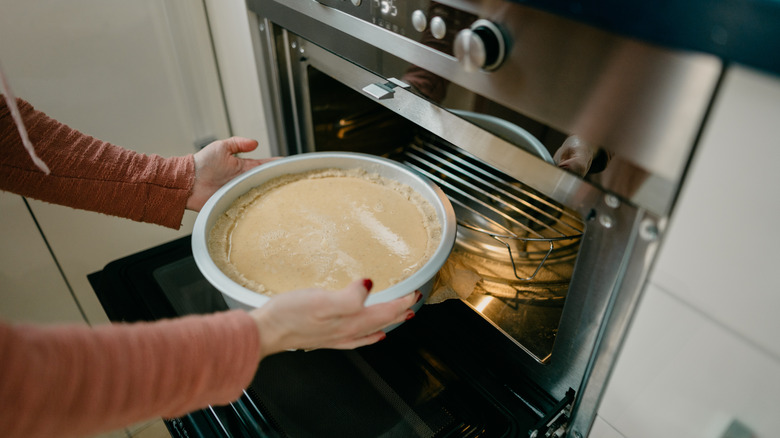The Easiest Solution To Fix A Cracked Cheesecake
No matter the recipe followed or steps taken, sometimes homemade cheesecakes come out of the oven with a cracked top. Though this may be frustrating, you can salvage your cheesecake rather easily by adding a tasty layer to the top.
Simply mix together sour cream, powdered sugar, and any spices (or extracts, like vanilla) you might have included in your cheesecake for flavor. For example, if you've used a pumpkin gingersnap cheesecake recipe, you might add cinnamon, allspice, and pumpkin puree to your topping. Pour this mixture over the top of your cheesecake, smooth it out, and bake it low in the oven until it sets. This usually doesn't take more than five minutes. Just like that, you've got a flawless cheesecake, complete with a delicious topping.
Alternatively, you can top a cracked cheesecake off with caramel sauce, chocolate ganache, fruit preserves, whipped cream, meringue, crushed nuts, or even cookie crumbles –- whatever complements the flavors beneath. Not only do these toppings hide the cracks, but who's going to care about the cracks anyway when your cheesecake tastes amazing?
Why do cheesecakes crack while baking?
Though a cracked cheesecake is easily fixable and nothing to be ashamed of, it may help to know how cracking can occur in the first place. After all, if you know what can cause cracking, you may be able to avoid it happening.
The most common cause is the cheesecake overbaking, effectively drying out. Because too much moisture has evaporated in the oven, the cheesecake is too dry to stick together. To prevent your cheesecake from drying out, you can either set a roasting pan of water beneath the cheesecake as it bakes or remove the cheesecake from the oven before it has fully set. After all, your cheesecake should ideally still have a bit of wobble to it. Regardless of whether or not you use the water pan method, you should never bake a cheesecake on the top rack of your oven. Instead, aim for the middle.
Another cause of cracking is the sudden temperature change from inside the oven to outside. To avoid shocking the dessert, you can let the cheesecake rest in the oven with the door slightly ajar — or experiment with a closed door, adjusting oven temperature and cook time until you find the perfect formula for your particular recipe.
How to fix a toppings-less cheesecake
Of course, not every cheesecake has toppings; some are just pure cheesecake. So, what do you do when your plain cheesecake comes out of the oven with an unseemly crack in its top, and no chocolate ganache or candied nuts to hide beneath?
First, let the cheesecake cool completely, so there's no risk of further cracking. Once the cheesecake has fully set, you can gently press smaller, superficial cracks together with your fingers. Smooth the cracked area with a hot knife or offset spatula (warmed in a bowl of hot water — just be sure to dry the utensil before fixing) until the cheesecake's top looks as good as new. Longer cracks are more difficult to fix, but not impossible. Gently hold the cheesecake on either side, pressing it together to seal the crack. This may not work, but it's your best shot.
Unfortunately, the reality of a large, deep crack is that you won't ever be able to completely reverse the damage. In these instances, your best bet is to revert to our first hack and top your cheesecake off with a tasty new layer.



